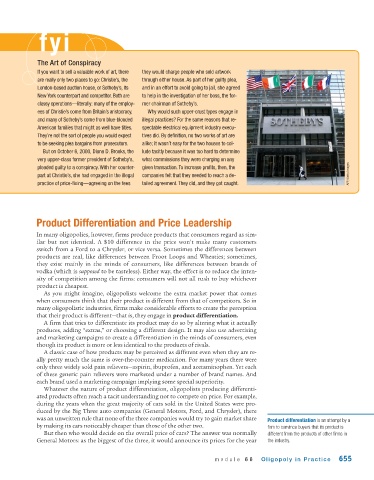Page 697 - Krugmans Economics for AP Text Book_Neat
P. 697
fyi
The Art of Conspiracy
If you want to sell a valuable work of art, there they would charge people who sold artwork
are really only two places to go: Christie’s, the through either house. As part of her guilty plea,
London-based auction house, or Sotheby’s, its and in an effort to avoid going to jail, she agreed
New York counterpart and competitor. Both are to help in the investigation of her boss, the for-
classy operations—literally: many of the employ- mer chairman of Sotheby’s.
ees of Christie’s come from Britain’s aristocracy, Why would such upper-crust types engage in
and many of Sotheby’s come from blue-blooded illegal practices? For the same reasons that re-
American families that might as well have titles. spectable electrical equipment industry execu-
They’re not the sort of people you would expect tives did. By definition, no two works of art are
to be seeking plea bargains from prosecutors. alike; it wasn’t easy for the two houses to col-
But on October 6, 2000, Diana D. Brooks, the lude tacitly because it was too hard to determine
very upper-class former president of Sotheby’s, what commissions they were charging on any
pleaded guilty to a conspiracy. With her counter- given transaction. To increase profits, then, the
part at Christie’s, she had engaged in the illegal companies felt that they needed to reach a de- AFP/Getty Images
practice of price-fixing—agreeing on the fees tailed agreement. They did, and they got caught.
Product Differentiation and Price Leadership
In many oligopolies, however, firms produce products that consumers regard as sim-
ilar but not identical. A $10 difference in the price won’t make many customers
switch from a Ford to a Chrysler, or vice versa. Sometimes the differences between
products are real, like differences between Froot Loops and Wheaties; sometimes,
they exist mainly in the minds of consumers, like differences between brands of
vodka (which is supposed to be tasteless). Either way, the effect is to reduce the inten-
sity of competition among the firms: consumers will not all rush to buy whichever
product is cheapest.
As you might imagine, oligopolists welcome the extra market power that comes
when consumers think that their product is different from that of competitors. So in
many oligopolistic industries, firms make considerable efforts to create the perception
that their product is different—that is, they engage in product differentiation.
A firm that tries to differentiate its product may do so by altering what it actually
produces, adding “extras,” or choosing a different design. It may also use advertising
and marketing campaigns to create a differentiation in the minds of consumers, even
though its product is more or less identical to the products of rivals.
A classic case of how products may be perceived as different even when they are re-
ally pretty much the same is over-the-counter medication. For many years there were
only three widely sold pain relievers—aspirin, ibuprofen, and acetaminophen. Yet each
of these generic pain relievers were marketed under a number of brand names. And
each brand used a marketing campaign implying some special superiority.
Whatever the nature of product differentiation, oligopolists producing differenti-
ated products often reach a tacit understanding not to compete on price. For example,
during the years when the great majority of cars sold in the United States were pro-
duced by the Big Three auto companies (General Motors, Ford, and Chrysler), there
was an unwritten rule that none of the three companies would try to gain market share Product differentiation is an attempt by a
by making its cars noticeably cheaper than those of the other two. firm to convince buyers that its product is
But then who would decide on the overall price of cars? The answer was normally different from the products of other firms in
General Motors: as the biggest of the three, it would announce its prices for the year the industry.
module 66 Oligopoly in Practice 655

